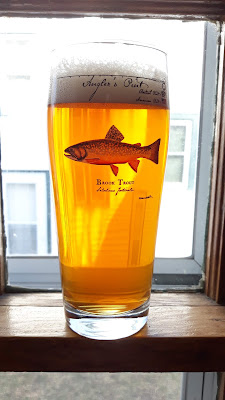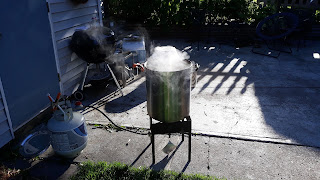Priming with DME
I've been having great success bottle conditioning using DME. It produces excellent head retention and pleasant carbonation.
4.5 oz of pilsen or light DME / 5 gal produces a "normal" level of carbonation. I'll use less for stouts and milds.
The DME may not mix well, I add it before I prep my bottling supplies and give it a final mix before I start bottling. This should prevent any large chunks of DME from being added to a bottle. A better choice is to dissolve the DME in about a half pint hot water before adding it to the finished.
Experimenting with Fizzy Drops (candy sugar) and Prime Dose (sugar + yeast).
The beer I used for this is Northern Brewer's ESB kit bottled in 12 oz bottles.
Method
Control - no priming sugar added
PD1 - one Prime Dose pill added
PD2 - two Prime Dose pills added
FD - one Fizzy Drop added.
From left to right, control, PD1, PD2, FD.
Results
Carbonation:
The beer w/ no sugar added was surprisingly well carbonated. (Traditional real ale is often not primed but requires a long conditioning, 3-4 months, in the cask or bottle before it's ready.) Both the control and PD1 were under carbonated (but maybe appropriate for an English Real Ale). PD1 may work well for a beer where a lower level of CO2 is desired. (I'm trying it in a best bitter) PD2 seemed over carbonated but it soon settled down and was spot on. The FD seemed over carbonated to me. (this is what lead me to try out Prime Dose)
Bottles primed with FD and aged become WAY over carbonated.
Taste:
I did notice some taste differences. The PD pills contain yeast and sugar. I wonder if the new yeast can out produce the existing yeast. That may have been where the flavor difference is coming form. (although it could have been in my head) To test this I'd have to repeat with a more neutral beer.
Head Retention:
This was an unexpected result. The lack of head retention was something that I've noticed with other beers primed w/ FD but I didn't think much of it as soap scum on the glass often kills HR. (this seems to be a common thing with the FD I've seen it in the other beers primed this way) PD2 had the best retention w/ PD1 having slightly less.
Next
I'd like to repeat this with corn sugar, light malt extract, PD2, FD.
Using Growlers
I successfully bottle conditioned my beer in a growler using 6 Fizzy Drops. (dark Mild) It built up quite a bit of pressure but the poly cap held and the sound it made when it was opened was cool. (This is where the term "growler" comes from :) A lot of sediment was left in the bottom of the growler but it stayed on the bottom and the beer poured decently. (West Yorkshire) Every time you fill a growler you should be using a new cap. (unless you're using a poly cap?)
Racking Cane vs. Bottling bucket
The bottling bucket is WAY easier. I've always used a racking cane with a bottle filler. Then I picked up a 3 foot length of hose and found out that I've been doing it wrong all along. The bottling bucket can be moved around easily. After tipping it forward to get all the beer out there's about 12 oz remaining and it's full of garbage that you'll want to dump anyway.
I've used the bottling bucket as a primary fermenter, it works just fine. It has the added benefit of moving beer into a keg or bottle without exposing it to too much oxygen. Just hook up the tap to a piece of tube and let it rip. You can even purge your keg with CO2 beforehand.
(Copied from my Google Sites page, written in 2010 ish)
- BrewNorth
































